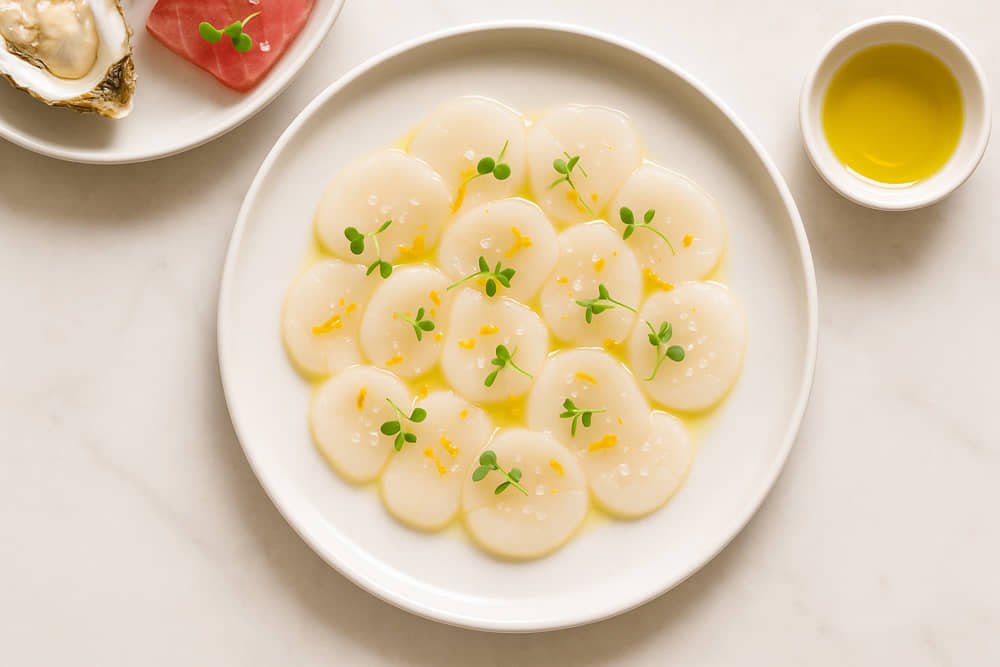Italian crudo is a celebration of simplicity, purity, and high-quality ingredients. Among the standout stars of this raw preparation is the scallop—tender, sweet, and delicate enough to shine with just a touch of seasoning. While crudo can include a variety of seafood, raw scallops in Italian crudo hold a special place on the plate for their refined texture and clean ocean flavor.
This dish represents the essence of Italian culinary philosophy: letting top-tier ingredients speak for themselves. With the rise of global appreciation for raw seafood dishes, from Japanese sashimi to Peruvian ceviche, Italian crudo has found its own spotlight—especially in upscale restaurants and home kitchens alike. This article will guide you through the tradition, technique, and pleasure of enjoying raw scallops as part of this elegant culinary staple.
Contents
What Is Italian Crudo?
Crudo, meaning “raw” in Italian, is a style of preparing raw seafood that emphasizes minimalism and freshness. Unlike ceviche, which typically relies on citrus to “cook” the fish, or sashimi, which is rooted in Japanese precision, Italian crudo uses just a few complementary ingredients—such as high-quality olive oil, sea salt, and citrus zest—to enhance the natural flavor of the fish or shellfish.
The tradition of crudo originates from coastal regions of Italy, particularly in the south—like Puglia and Sicily—where fishermen would eat just-caught seafood dressed with local olive oil and lemon. Over time, crudo has evolved into a refined dish served in gourmet restaurants, yet it still retains its rustic charm and emphasis on freshness.
In this context, raw scallops in Italian crudo exemplify this harmony between ingredient and simplicity. Their soft, buttery texture and naturally sweet taste make them perfect candidates for the crudo approach, highlighting both tradition and innovation on a single plate.
Why Raw Scallops Shine in Crudo Dishes
Raw scallops are among the most luxurious ingredients you can feature in a crudo. Their translucent flesh, delicate brine, and subtle sweetness offer a sensory experience that’s both clean and indulgent. When sliced thin and seasoned sparingly, scallops reveal layers of flavor that cooked versions might mask.
One of the key reasons raw scallops excel in crudo dishes is their natural texture—silky yet firm, making each bite both tender and satisfying. They don’t require much to be elevated; in fact, too much seasoning or acid can overpower their nuanced flavor.
Their nutritional profile also adds to their appeal. Scallops are rich in lean protein, omega-3 fatty acids, and essential minerals like magnesium and phosphorus, making them a wholesome option for raw seafood enthusiasts. To better understand the safety and best practices when eating scallops raw, check out our guide: Can You Eat Scallops Raw?
Sourcing the Freshest Scallops for Crudo
The success of raw scallops in Italian crudo depends almost entirely on the quality and freshness of the scallops you use. Look for scallops labeled “sashimi-grade” or “sushi-grade,” which indicates they have been handled and frozen according to standards suitable for raw consumption. Alternatively, “diver-caught” scallops, which are harvested by hand, tend to be fresher and more sustainable than those collected by trawl nets.
When choosing between sea scallops and bay scallops, both can work for crudo, but they deliver different textures and flavors. Sea scallops are larger, meatier, and slightly more savory, while bay scallops are smaller, sweeter, and more delicate. The choice depends on your flavor preference and how you plan to present the dish. If you’re unsure which type to use, our detailed comparison might help: Sea Scallops vs. Bay Scallops: What’s the Difference?
Appearance and smell are crucial indicators of freshness. Raw scallops should look translucent and glossy, with a mild ocean scent—never fishy or sour. If buying from a seafood counter, ask when the scallops arrived and whether they were previously frozen. For best results, use them the same day you purchase.
Preparation Techniques: From Cleaning to Slicing
Preparing scallops for crudo requires precision and care. Start by gently rinsing the scallops under cold water to remove any residual sand or grit. Then, pat them dry with paper towels—moisture can dull the flavor and interfere with the clean texture you want in a crudo dish.
Next, check for the side muscle—a small, tough flap of tissue that should be removed as it becomes chewy when eaten raw. Simply pinch and pull it off with your fingers.
For slicing, use a sharp knife to cut the scallops horizontally into thin, even discs. This increases surface area, allowing them to better absorb the oil, salt, and citrus without overwhelming their delicate taste. Chill the slices immediately before plating to maintain both food safety and ideal texture.
Flavor Pairings and Garnishes in Italian Crudo
Italian crudo thrives on balance—between richness and acidity, softness and crunch, simplicity and complexity. When working with raw scallops, this principle is key. Classic garnishes include extra-virgin olive oil, flaky sea salt, fresh lemon juice or zest, and cracked pink peppercorns. These elements draw out the natural sweetness of the scallops without overpowering them.
For more adventurous flavor profiles, try additions like microgreens, fresh herbs (especially basil or mint), or thinly sliced chili for heat. Fruity elements such as pomegranate seeds or citrus segments offer bursts of brightness, while a few drops of white balsamic or aged vinegar can add depth.
Texture also matters. Consider pairing the soft scallops with crispy shallots, toasted pine nuts, or even shaved fennel for contrast. The key is restraint—let the scallops remain the star of the dish.
How to Serve Raw Scallops Crudo at Home
Serving raw scallops crudo at home may seem intimidating, but with the right approach, it’s surprisingly simple and rewarding. The key is to keep your focus on freshness, technique, and presentation. Begin by preparing your scallops shortly before serving to ensure optimal texture and flavor. Thin slices arranged artfully on a chilled plate—such as marble, ceramic, or even a block of Himalayan salt—can make a big visual impact.
Before plating, season the scallops lightly with flaky salt, a few drops of high-quality olive oil, and a touch of citrus zest. If desired, garnish with microgreens or paper-thin slices of radish for a bit of crunch and contrast. Avoid adding strong acids like lemon juice too early, as they can begin to “cook” the scallops and change their texture—serve immediately after dressing for best results.
Crudo is traditionally served as an appetizer, either individually plated or family-style. It pairs beautifully with crisp white wines such as Pinot Grigio or Vermentino, which complement the dish’s freshness without overwhelming its delicacy.
While preparing crudo at home, always emphasize food safety. Use scallops that are clearly labeled for raw consumption and handle them with clean utensils and surfaces. When in doubt, freeze the scallops at -20°C (-4°F) for at least 7 days to reduce the risk of parasites, following FDA guidelines for raw seafood.
Conclusion
Italian crudo is a tribute to simplicity and elegance, and raw scallops are its perfect muse. Their mild sweetness, supple texture, and ability to absorb subtle seasoning make them a standout choice for both chefs and home cooks looking to explore refined seafood preparations.
By understanding how to source the freshest scallops, master the art of slicing and seasoning, and appreciate the minimalism at the heart of crudo, you can bring this sophisticated Italian dish into your own kitchen. Whether served at a summer dinner party or enjoyed as a personal indulgence, raw scallops in Italian crudo offer an unforgettable experience of purity and taste.



